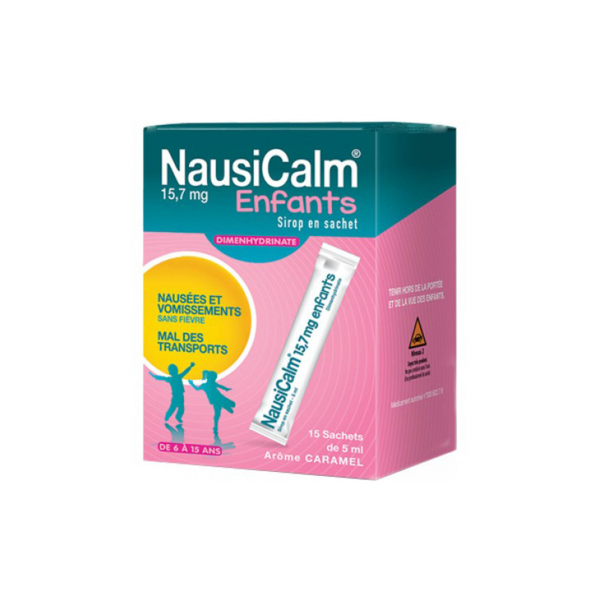This medication belongs to a family of medications called antihistamines. Histamine is a natural component that plays an important role in nausea, vomiting and motion sickness. The active substance in this medicine works by blocking the release of histamine in the body.
You should contact your doctor if you do not feel any improvement or if you feel less well 2 days.
If your doctor has told you that you have an intolerance to certain sugars, contact your doctor before taking this medicine. Never give NAUSICALM 15.7 mg CHILDREN, syrup in sachet:
- If your child is allergic to the active substance (dimenhydrinate) or to any of the other ingredients of this medicine mentioned in section 6.
If your child is allergic to a medicine from the same family as NAUSICALM 15.7 mg CHILDREN SYRUP BAG (antihistamines) used to treat allergies.
- if your child has glaucoma (caused by increased pressure inside the eye).
If your child has difficulty urinating.
· If your child is under 6 years old. Nausea and vomiting in children under 6 years old can have various origins. In this case, you must bring your child to see a doctor.
Warnings and Precautions
The use of this medicine is not recommended in patients with fructose intolerance, glucose-galactose malabsorption syndrome or sucrase / isomaltase deficiency (rare hereditary diseases).
This medication contains 3.6 g of sucrose per sachet which must be taken into account in the daily ration in the event of a low-sugar diet or diabetes.
This medicine contains methyl parahydroxybenzoate (E218) and propyl parahydroxybenzoate (E216) and may cause allergic reactions.
This medicine contains 106 mg of ethanol (alcohol) per sachet. The use of this medicine is dangerous in alcoholics and should be taken into account in pregnant or breastfeeding women, children and high-risk groups such as patients with hepatic impairment or epilepsy.
To be on the safe side, do not give this medicine if your child has bronchial asthma. The occurrence of signs or symptoms suggestive of abuse or drug dependence of dimenhydrinate should be carefully monitored.
Pregnancy and breast feeding
Although this medication is for children 6 to 15 years old, the following recommendations are given for information: Do not take this medication without asking your doctor or pharmacist for advice.
Pregnancy
This medicine will only be used during pregnancy on the advice of your doctor. If you discover that you are pregnant during treatment, consult your doctor as only he can judge the need for continued treatment. At the end of pregnancy, this medicine can cause harmful effects in the newborn baby. Therefore, you should always seek the advice of your doctor before using it and never exceed the recommended dose. Ask your doctor or pharmacist for advice before taking any medicine.
Feeding with milk
This medicine passes into breast milk. Therefore, it is not recommended to be used while breastfeeding. Ask your doctor or pharmacist for advice before taking any medicine.
HOW TO TAKE NAUSICALM 15.7 mg CHILDREN, syrup in sachet?
If you are giving this medicine to prevent or treat motion sickness
For children 6 to 15 years old: The dose to use is 1 to 2 sachets. You should not exceed 10 sachets per day (i.e. 150 mg / day).
If you are giving this medicine to treat nausea and vomiting without fever
For children 6 to 15 years old: the dose is 1 to 2 sachets every 6 to 8 hours. You should not exceed 10 sachets per day (i.e. 150 mg / day).
Method of administration This medication is for oral use.
Frequency of administration If you are giving NAUSICALM 15.7 mg CHILDREN, syrup in a sachet to prevent motion sickness, administer it half an hour before departure. During the trip, it may be taken again, without exceeding the maximum recommended doses.
Duration of treatment
To treat nausea and vomiting without fever: do not exceed 2 days of treatment. If the symptoms persist beyond 2 days, consult your doctor.
To prevent and treat motion sickness: the medicine will only be used before and possibly during transport. If you take more NAUSICALM 15.7 mg CHILDREN, syrup in sachet than you should: Faintness or disturbance of consciousness may occur. Stop treatment and see your doctor immediately.
SIDE EFFECTS
Like all medicines, this medicine can cause side effects, although not everybody gets them. The following effects may occur and require immediate discontinuation of treatment. You must tell your doctor:
· An allergy. You will recognize it by pimples, itching, redness on the skin, sudden swelling of the neck and face. If any of these effects occur, stop the drug and contact a doctor immediately.
If you have a fever with or without signs of infection. This could be a severe drop in white blood cells in the blood.
- if you have bleeding from the nose or gums. This could be an abnormal drop in the number of platelets in the blood. Other effects may occur: n falling asleep, reduced alertness, memory or concentration problems,
Dizziness, balance disorders, movement disorders (motor incoordination), tremors, Confusion, hallucinations, Dry mouth,
Visual disturbances
Difficulty urinating (urinary retention),
Constipation
- Palpitations of the heart, low blood pressure.
More rarely, signs of excitement (restlessness, nervousness, sleeplessness) may occur.
Very rare cases of abnormal head and neck movements may occur.
Reporting of side effects If you get any side effects talk to your doctor or pharmacist. This also applies to any side effects not mentioned in this leaflet. You can also report side effects directly via the national reporting system: National Agency for the Safety of Medicines and Health Products (ANSM) and network of Regional Pharmacovigilance Centers - Website: www.ansm.sante.fr By reporting the side effects, you can help provide more information on the safety of this medicine.


 100% secure payment, Customer Satisfaction
100% secure payment, Customer Satisfaction
 Order shipped within 24 hours from Monday to Friday*
Order shipped within 24 hours from Monday to Friday*


